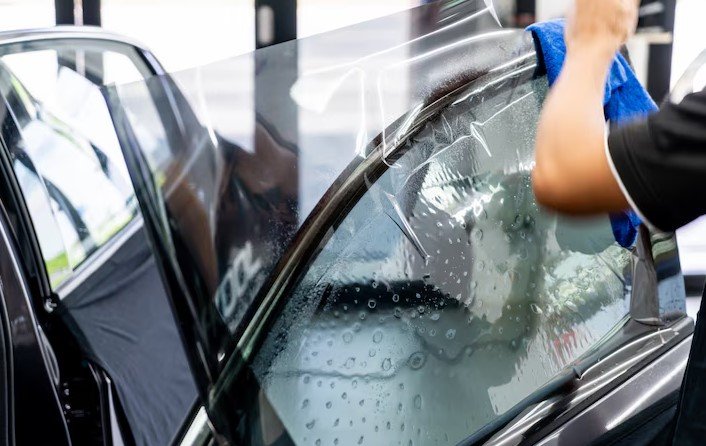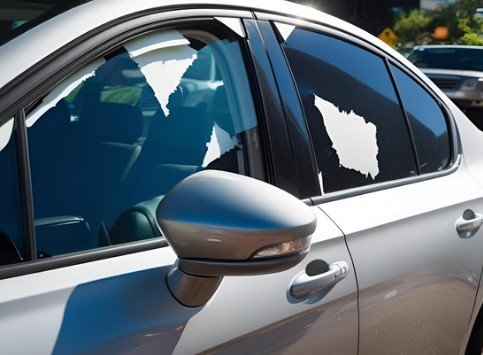Window tinting offers many benefits—privacy, UV protection, and heat reduction—but over time, that sleek film can become more of a hassle than a help. You might notice fading, bubbling, peeling, or even a purple hue, all signs that your tint has worn out. In other cases, outdated tint may violate Texas tint laws, especially on vehicles, prompting the need for removal.
Whether you’re looking to remove auto window tint, peel film off your office or storefront, upgrade home window tinting, or replace tint on a boat, the process shares some basics—but each setting comes with its own set of challenges.
This guide walks you through everything you need to know before getting started. You’ll learn DIY removal tips, the tools involved, and when it’s better to leave it to the professionals at Texas Auto Glass Pro Houston’s most trusted window tint removal and installation experts.
1. What You Need to Know Before You Remove Window Tint
Before you start scraping away that old tint, there are a few crucial factors to consider.
1 Legal Considerations
In Texas, auto window tint must meet specific visibility and reflectivity standards. If your tint is too dark or reflective, you could face fines or inspection issues. Removing illegal tint before it becomes a legal or resale problem is smart—especially on front windows and windshields.
2 Potential Damage Risks
Removing tint improperly can scratch your glass, ruin defrost lines, or damage rubber seals and electronic components—especially in modern vehicles. On commercial or residential windows, large panes and sensitive film types require careful handling to avoid cracks or adhesive smears.
3 Time and Labor
DIY removal might seem simple, but it can take hours, depending on the age and type of tint. Removing sticky adhesive is often more frustrating than peeling the film itself. Add ladders and high windows to the mix (for commercial or home jobs), and it can become a full-day project.
4 DIY vs. Professional Removal
- DIY may work if you’re handy, have time, and your tint is relatively new.
- Professional help is better for:
- Older tint jobs with stubborn adhesive
- High or hard-to-reach windows (offices or homes)
- Vehicles with defrost lines and sensors
- Boats with curved marine glass
2. How to Remove Auto Window Tint (Cars & Trucks)

Old or damaged tint on your car can look bad, reduce visibility, and even make your vehicle illegal in some states—including Texas. If you’re ready to remove auto window tint from your car or truck, here’s what you need to know.
Tools You’ll Need
- Steamer or heat gun
- Razor blade or scraper with plastic edge
- Ammonia or vinegar solution
- Spray bottle and microfiber cloths
- Garbage bags or newspaper
- Safety gloves and goggles
Note: Always work in a well-ventilated area, especially when using ammonia.
Step-by-Step Instructions
For Side Windows
- Roll the window down slightly for full edge access.
- Apply heat with a steamer or heat gun to loosen adhesive.
- Slowly peel the tint from one corner using your fingernail or a plastic blade.
- Spray adhesive residue with ammonia/vinegar and cover it with a black plastic bag (for sun-activated softening).
- After 15-30 minutes, scrape off the residue and clean thoroughly.
For Rear Windows (with Defrost Lines!)
- Be extra careful—defrost lines are delicate and easy to damage.
- Use a steamer rather than a razor blade to soften and lift the tint.
- Gently pull the film away while continuing to apply heat.
- Use a soft cloth to remove residue instead of scraping directly over the defrost lines.
⚠️ Be Cautious with Rear Defrosters
Damaging the defrost lines could cost you hundreds in repairs. That’s why many car owners leave this job to professionals.
💡 Too tricky? Let the experts at Texas Auto Glass Pro handle it safely and efficiently.
👉 Contact us now for auto tint removal in Houston.
🔹 3. How to Remove Window Tint from Commercial Properties
Removing window tint from a commercial building can be more complex than it looks. Businesses often remove tint due to branding changes, sun damage, privacy updates, or building renovations. But commercial windows aren’t like car windows—they’re usually larger, higher, and made with special coatings.
Types of Commercial Window Tint
- Solar control films (reduce heat and glare)
- Security films (add break resistance)
- Decorative films (frosted, etched looks for branding)
Each type requires different handling. For example, security film is thick and layered, making removal slow and adhesive-heavy.
Challenges of Commercial Tint Removal
- Large glass panes mean more surface area and adhesive
- Tall windows may require ladders, scaffolding, or lifts
- Improper removal may void window warranties
- Some buildings have specific insurance and safety protocols
For these reasons, commercial window tint removal is best left to experienced pros who understand the risks and can work efficiently.
💼 Commercial tint removal done right – Texas Auto Glass Pro serves Houston businesses with professional-grade equipment and trained technicians.
👉 Book a commercial tint removal service
4. How to Remove Tint from Home Windows
Homeowners often remove window tint due to UV damage, bubbling, discoloration, or to install a newer, energy-efficient film. While the basics are similar to cars, home window tint presents a different set of considerations.
Why It’s Different from Car Tint
- Glass types vary (tempered, double-pane, etc.)
- Tints are often older or sun-baked, making adhesive tougher
- Large or high windows may be dangerous to access
- Windows might have treatments, coatings, or films layered over time
Recommended Tools & Solutions
- Ammonia or commercial window film remover
- Plastic scraper (never metal!)
- Spray bottle, towels, and cloths
- Heat gun or hairdryer for stubborn sections
Apply remover, wait 20–30 minutes, then gently peel and wipe clean. Take extra care with double-pane windows to avoid damage or moisture intrusion.
5. How to Remove Tint from Boat Windows
Marine window tinting serves practical purposes—UV protection, glare reduction, and cabin cooling—but over time, it can fade, peel, or bubble just like car or home tint. When that happens, removing tint from boat windows brings a new set of challenges.
Unique Challenges with Marine Tint
- Curved glass: Most boat windows aren’t flat, making peeling more complex.
- High humidity & salt exposure: Adhesive can degrade unevenly or become sticky and gummy.
- Delicate finishes: Boats often have specialty coatings or plastic windows that can be easily scratched.
Step-by-Step Marine Window Tint Removal
- Clean the glass with mild soap to remove salt and debris.
- Apply gentle heat using a steamer or heat gun (low setting).
- Slowly peel off the tint, working with the curve of the window.
- Use marine-safe adhesive remover to clear leftover residue.
- Polish and clean with a UV-protectant cleaner for marine glass or plastic.
Never use harsh chemicals or blades on plexiglass windows.
6. Common Mistakes to Avoid During Tint Removal

Even small errors during window tint removal can lead to costly damage or frustrating results. Here’s what to watch out for:
1. Scratching the Glass
Using metal blades or scraping too aggressively can leave permanent scratches, especially on tempered or coated glass.
2. Damaging Electronics
In vehicles, defrost lines, rain sensors, and antenna wires are fragile. One slip could mean expensive repairs.
3. Leaving Adhesive Behind
Peeling the film is easy. Removing all the sticky residue? Not so much. Skipping this step can cause dirt buildup or problems when applying new tint.
4. Using Harsh Chemicals
Household cleaners or strong solvents may damage rubber trims, window seals, or tint-friendly coatings on glass.
💡 Avoid these costly mistakes—trust certified professionals instead.
👉 Book a safe, professional tint removal with Texas Auto Glass Pro today.
7. Professional Window Tint Removal in Houston, TX
Whether it’s a car, home, office, or boat, removing window tint properly takes skill, experience, and the right tools. That’s why many Houstonians choose Texas Auto Glass Pro for expert tint removal across all applications.
Why Hire a Certified Tint Expert?
- No risk of damage to glass, trim, or electronics
- Quick turnaround and spotless finish
- Safe disposal of film and adhesive
- Access to the right tools and non-damaging solutions
Why Choose Texas Auto Glass Pro?
- 5-star reviews from happy customers
- Specializes in auto, commercial, home, and boat tint removal
- Locally trusted throughout Houston
- Satisfaction guaranteed with every service
- Also offers professional re-tinting and film upgrades
FAQs About Window Tint Removal
How long does it take to remove window tint?
It depends on the type of tint and the size of the glass. For example:
- Auto windows: 1–3 hours
- Home or commercial windows: Several hours to a full day
- Boat windows: Varies based on window material and condition
DIY can take longer—professionals get it done faster and cleaner.
How much does it cost?
Pricing depends on the number of windows, the type of film, and whether adhesive removal is involved. Here’s a rough guide:
- Cars: $90 – $250
- Commercial/Residential: $5 – $15 per square foot
- Boats: Custom quotes only
👉 Contact Texas Auto Glass Pro for a free, personalized quote.
Can you reuse window tint after removal?
No. Once removed, tint film loses its adhesive properties and cannot be reapplied. Reinstallation always requires new, high-quality film.
Is tint removal safe for all glass types?
Yes—with the right tools and experience. But DIY attempts can scratch glass, damage coatings, or break defrost lines. That’s why professional removal is strongly recommended, especially for:
- Curved or tempered glass
- Double-pane windows
- Defroster-equipped auto glass
Ready to Remove Your Tint the Right Way?
Whether you’re dealing with peeling tint on your car, outdated film on your office windows, UV-damaged home tint, or weather-worn boat glass—window tint removal doesn’t have to be a hassle.
Texas Auto Glass Pro makes it easy with:
- Expert technicians
- Fast turnaround times
- Residential, commercial, auto & marine service
- Houston’s most trusted team for tint installation and removal

